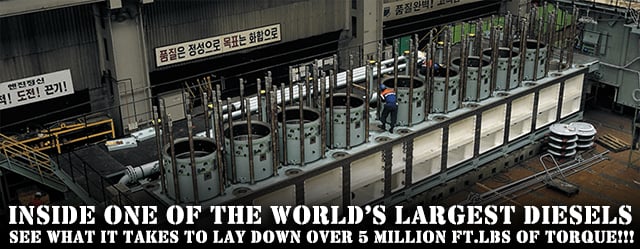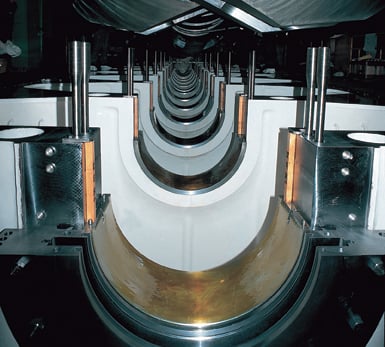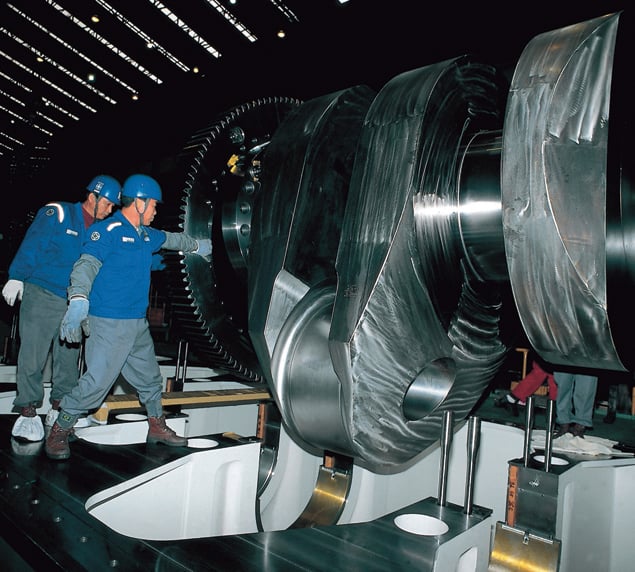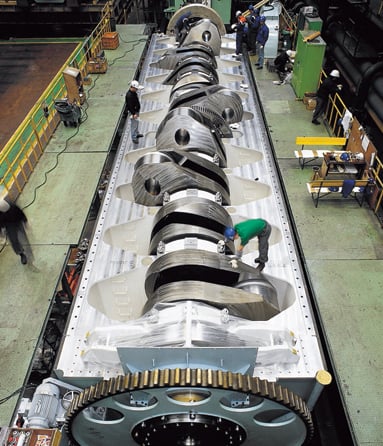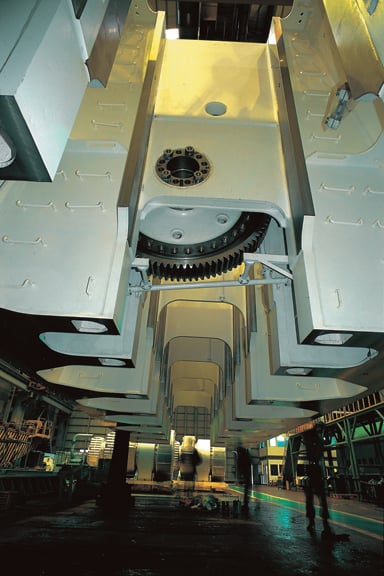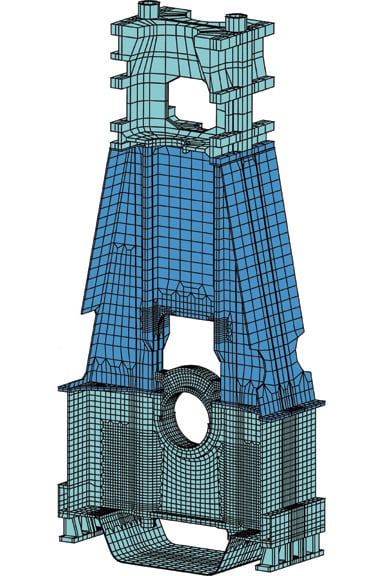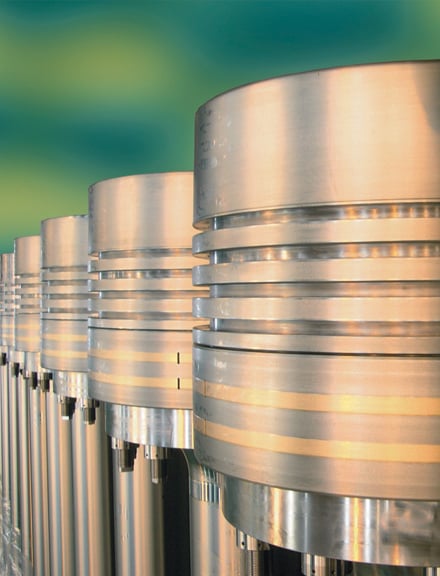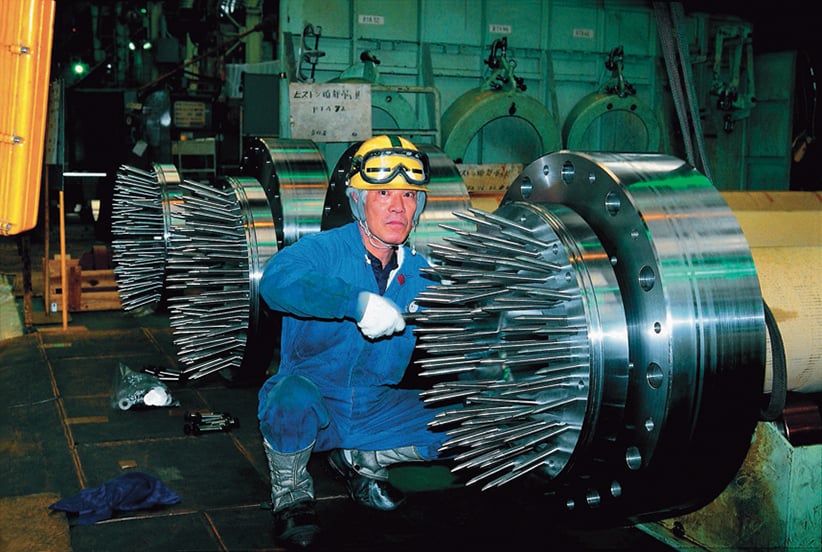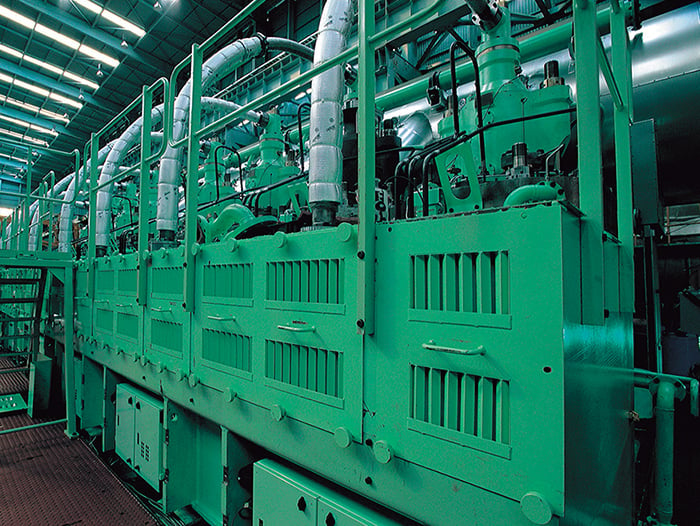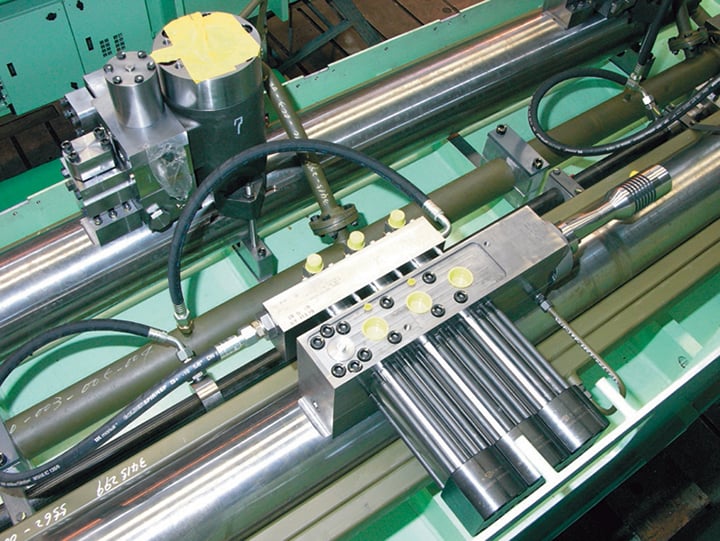Written and Compiled By Stephen K. Anderson
While innovators the world over focus on maximizing vehicle efficiency and spending billions downsizing transportation to save pennies, there are those proving bigger can still be better. While some may scoff at the thought, these grand concepts are silencing skeptics with amazing capabilities that lead the way in making the most of more.
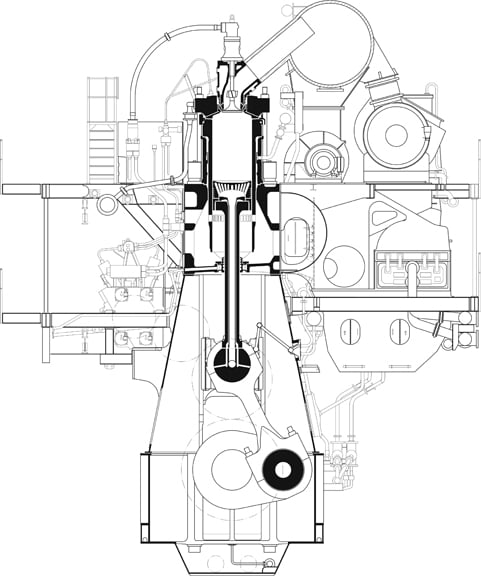 [2]
[2](Illustration of end view of RT-flex96c engine)
In every way, the Wartsila RT-flex96C is unlike conventional diesel engines, as can be seen in this diagram. Extremely reliable, powerful ad efficient, it is also on a scale that dwarfs every other engine in operation today.
As your consider which of the latest batch of diesel pickups lead this rush toward mechanized nirvana, think beyond Cummins [3]’ inline six for the answer. While the engine we’re showcasing here is an inline, it has eight more cylinders, each one large enough to inhale diminutive diesels. This giant is in a class by itself in terms of power output, fuel requirements, and efficiency standards. Thinking diesel locomotive or the power plant for a factory? Think bigger!
Looking more like a multi-story industrial building than a low speed turbocharged two-stroke diesel engine, the Wartsila [4] RT-flex96C is unlike anything engineered before, from its massive specifications to its innovative technology, and industry leading capabilities. If you haven’t figured it out already, this engine was conceived to power the world’s largest container ships.
Capable of hauling 13,000 twenty-foot shipping containers between the largest deep-water ports in the world, the latest 1,200 x 161 x 50-foot Panamax container ships required the multi-billion dollar expansion of the Panama Canal, and an engine capable of pushing those ships through it and on up to 25 knots!
(Left) From this view, its difficult to gauge the size of this 14-cylinder low speed diesel engine, though you could probably fit an average sized pickup truck tire within the main bearing. The studs extending from the bedplate are well over three inches in diameter. (Right) This view allows a better understanding of just how large this engine is. Here two technicians attempt to guide the 300-ton crankshaft into position before it is lowered into the main bearings. Try and imagine what machine was capable of shaping these components with absolute precision.
(Left) Regardless of their size, all RT-flex engines utilize a beautifully machined gondola-type bedplate engineered to provide a rigid platform for the crankshaft. Here a team oversees the final stages of the crankshaft installation in an eight-cylinder example. (Right) The cylinder jackets are created from individual cast-iron cylinder blocks that are bolted together for maximum rigidity, which adds to longevity. While similar to the 14-cylinder RT-flex96c engine, this particular example in assembly is a 10-cylinder version.
While there isn’t enough space here to describe the entire array of complex systems found throughout twenty different Wartsila low speed diesel engines, simply touching on the highlights of the largest confirms its true genius. A literal tour de force of advanced concepts, its unique design features and complex operating systems confirm Wartsila’s place as a leader in advanced engine design.
At 89 feet long and 44 feet high, and weighing 2,300 tons, the Wartsila RT-flex96C low speed turbocharged diesel engine churns out 108, 920 horsepower and a staggering 5, 608, 312 lbs./ft. of torque at 102 rpm! Consuming 1,660 gallons of heavy fuel per hour, it might seem like the ultimate fuel guzzler until you consider it exceeds 50% thermal efficiency in its maximum economy mode. In other words, 50% of its fuel energy is converted to motion, which is amazing when considering automotive engines achieve 25-30% thermal efficiency.
What might be considered to be the engine block in conventional terms is actually a combination of a elements starting with a gondola-type bedplate that secures the crankshaft. This is mated to a complex structure overhead that provides rigid support for the cylinder jackets, while isolating others aspects of the assembly from the immense forces that are almost beyond comprehension.
(Left) The purpose of the A-shaped, double-walled column structure fitted above the bedplate is to maintain absolute alignment of the cylinder jackets. Every aspect of these magnificent engines, from the computer modeling employed early on, to the final fitment of the components centers on maximizing longevity and efficiency. (Right) This finite-element model of the RT-flex96C structure allows analysis of the bedplate, welded columns, and individual cast iron cylinders long before the actual components are assembled and tested. If an issue is discovered, the design can be altered, thereby reducing setbacks in time and costs.
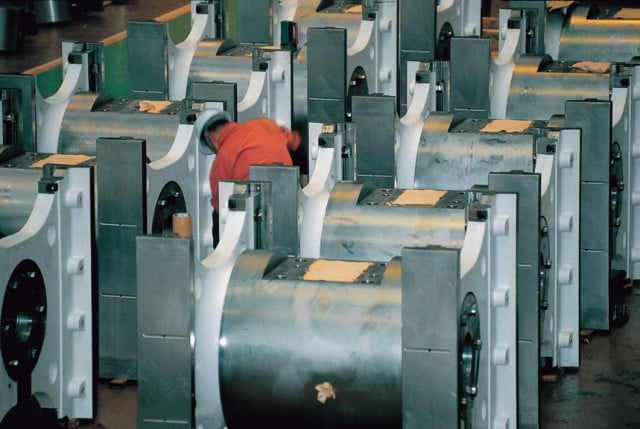 [11]
[11]Everything about this engine is larger than life, as can be seen in these crosshead pins with guide shoes, which are but one component of the immense rod assembly. Yet despite their giant dimensions, every aspect of their design is held to tight tolerances.
With a cylinder bore of slightly less than 38-inches and a stroke just over 98-inches, each of the 14 cylinders displace 111, 143 cubic-inches or 1,820-liters, and produce 7,780 horsepower. Together the immensity of 1,556,002 cubic-inches or 25, 480-liters is beyond the most fertile imagination. While the mass of this giant’s rotating assembly might seem to be its undoing, its tremendous inertia is actually key to its unequaled efficiency.
Considering the crankshaft alone weighs 300 tons, it’s intriguing to consider how its contours were shaped, and so it is with the piston and rod assemblies, which push conventional thinking right out the exhaust pipe. Unlike typical pistons and rods in automotive applications, the top of the connecting rod isn’t attached to the piston, but to a crosshead rod extending to the piston high above. Think of steam locomotives a century ago, and you’ll recognize the concept. Crosshead pins with guide shoes ensure the crosshead maintains its linear motion thereby keeping the cylinder walls circular. This approach also centralizes the forces exerted during combustion, thereby increasing efficiency.
(Top Left) Leading edge technology has fitted the giant pistons with chromium-ceramic coated, pre-profiled piston rings, anti-polishing rings, and twin bronze rubbing bands aligning the short piston skirts. There’s even a ring renewal system to extend service life. It’s only a matter of time until similar innovations find their way to our vehicles. (Top Right) A closer look at one of the giant pistons after a test run at 110-percent load provides a glimpse of the forces that are at work. You can also see the rings and ring lands, which you could put your fist into. Absolutely nothing about Wartsila's largest engine is on a scale most people can barely relate to. (Bottom Left) To manage temperatures within the pistons, these spikes on the piston's rods mate with holes in the bottom of the pistons, injecting oil inside the pistons to keep their tops from overheating. Once again, the scale of this engine demands innovative approaches to maintain reliability. (Bottom Right) While automotive engines utilize oil sprayed beneath the pistons to control temperatures, this view of the underside of these giant bore-cooled pistons take the concept to an entirely different level. The cavities allow oil to be sprayed within the piston dome, reducing the considerable temperatures that would otherwise do damage.
Further innovation comes in spikes in the piston’s rods extending through the bottom of the pistons, injecting oil beneath the piston crown to prevent overheating. This benefits from load dependent, electronically timed, pulse jet cylinder lubrication utilized elsewhere, distributing specialized lubricants that neutralize acids created by high sulfur fuel combustion.
(Left) The electronically controlled rail unit at the top level of the cylinders manages the fuel injection, exhaust valve actuation and air starting. As a result of this relatively new technology, the RT-flex96c engine no longer utilizes conventional camshafts, chain gear, fuel pumps, exhaust valve actuator pumps and reversing servomotors. (Right) A rare look inside the rail unit shows the exhaust valve actuator (top) mounted to the servo oil rail and injection control on the fuel rail (bottom). A smaller control oil rail and return pipe for servo and control oil runs through the center.
Unlike its predecessor, the RTA96C diesel engine, the RT-flex96C has negated the need for conventional camshafts, chain gear, fuel pumps, exhaust valve actuator pumps, and reversing servomotors through the utilization of common rail technology. This electronically controlled method benefits from microprocessor’s providing precise and reliable control of various engine systems including optimal fuel injection manipulation, valve timing, and air starting.
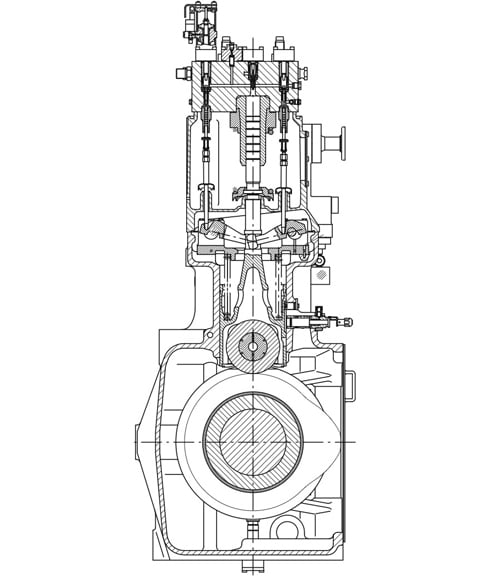 [18]
[18]The fuel injection pumps, like the valve drives, are double-valve controlled units, with separate suction and spill valves regulated through eccentrics on hydraulically-actuated lay shafts. This allows variable fuel injection timing for improved part-load fuel consumption and to allow for variance in fuel quality.
Scavenged air from inlet ports in the lower part of the cylinders is delivered by a high efficiency, constant-pressure, multi-turbocharger system benefiting from an electronically driven auxiliary supercharger accessed during starting and slow running. To expand on this system, 10-percent of the engine’s exhaust gas can be branched off to a power turbine package that adds up to 12-percent of engine power. As a result, low speed performance has been increased, while fuel consumption, emissions, and maintenance costs are lowered.
While some might question the logic of utilizing a single engine to power these immense ships, incredible reliability has been realized through integrated monitoring systems, ample capacities, and numerous redundant systems making them extremely cost effective. When servicing is needed, the crankcase can be accessed from both sides, where hoisting locations enable servicing of the piston rod gland and inspection of the piston rings.
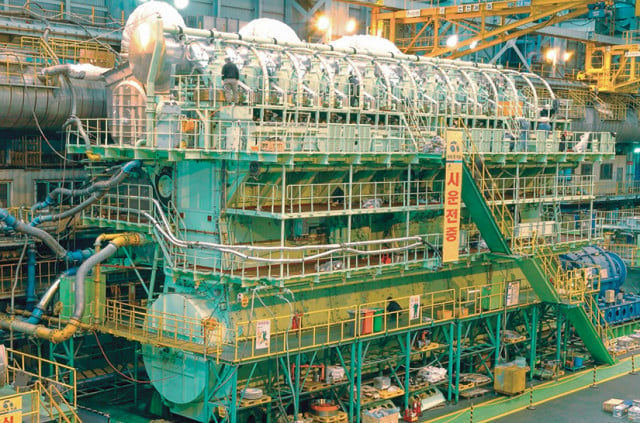 [19]
[19]While this is “only” a 12-cylinder version of Wartsila’s RT-flex96C low speed turbocharged diesel engine, the larger 14-cylinder version takes top honors as the largest internal combustion engine in the world, at least for now. Weighing 2,300 tons, it’s 44 feet high, almost 90-feet long, and produces 5.6-million lbs. ft. of torque and over 100,000 horsepower at 102 rpm!
In looking back through the development of diesel engines, there’s no question displacement has always been an integral part of their powerful equation. But today, the concept has been expanded to dimensions that are truly hard to imagine. As with every mechanical advancement that’s come before, know that ever larger ships are already in the works worldwide, and for these applications not one, but two of these giant engines will churn the ocean blue with twin screws.
The Wartsila RT-flex96C grew from the imagination of engineers who already thought they had accomplished the impossible, but no. As the costs of shipping products worldwide continue to rise, and ever more efficient ships were conceived to haul more containers, new concepts utilizing a single engine became the way to go. For now though, this is the largest reciprocating engine in the world, and it’s a diesel.
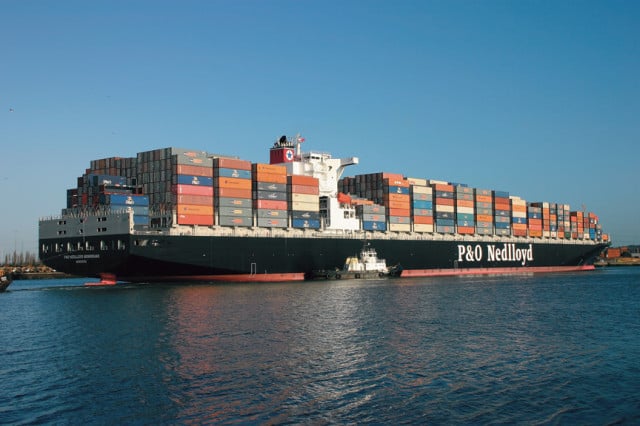 [20]
[20]If there’s any doubt about the capability of the RT-flex96c engine, consider that one of them is all that’s needed to push giant Panamax container ships like this one 25 knots using a single propeller, while producing amazingly low emission levels. Capable of hauling 1,300 containers, these 1,200 x 161 x 50-foot ships are some of the largest in service, and yet larger versions are under construction as you read this.
